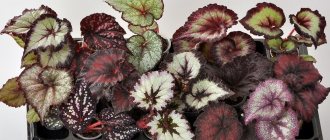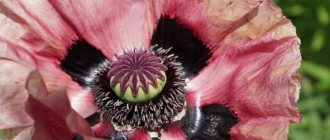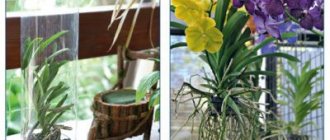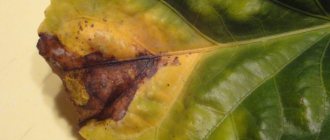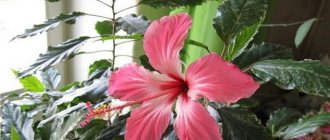In collections of plant design, hibiscus occupies not the last place. This majestic flower has long been loved by gardeners for its highly decorative leaves and variety of colors. The Chinese rose is especially beautiful during its flowering period. There are many varieties of indoor plants, the most popular is a plant with large red roses. Flowers are good because they can be propagated at home. Although these houseplants are considered low-maintenance, novice gardeners still need to learn the basic rules on how to root hibiscus.
General information about the flower
You may be interested in: Indian fern for an aquarium: photo and description, features of maintenance
Hibiscus is a grateful plant; with good care, it pleases flower growers with lush greenery and incredibly beautiful flowers. Among its many varieties there are both garden and indoor specimens. The hibiscus family contains the entire available palette of colors with the exception of blue and black. On average, the life cycle of a Chinese rose bush is 18-20 years. Indoor plants should be protected from negative external influences - direct sunlight and drafts. At the same time, the culture should not be deprived of sufficient light.
You may be interested in: Chlorophytum laxum: photo and description, home care
Reviews from gardeners
gripas-va
When the bush is 5-7 years old, under the beneficial influence of the sun's rays, the strong visual effect leaves (sorry) speechless. I initially realized that hibiscus is a benevolent friend even to an inexperienced gardener. I read that Europe has some great outdoor hibiscus gardens to visit.
Source: frauflora.ru
rada
At the age of 5-6 years, it has a trunk like an apple tree, height and diameter are 2-1.5 m, and produces up to 40-50 thousand flowers per season. The herbaceous hybrid hibiscus overwinters with buds in the ground; it is enough to put garden soil, pine needles or chrysanthemum branches on the bush. Hibiscus need LOTS OF SUN during the growing season.
Source: floralworld.ru
Reproduction methods
If you are a novice gardener, you most likely want to plant crops that are easy to care for. The Chinese rose is one of the simplest plants, despite the fact that it looks very luxurious. It is very easy to propagate. The easiest way, which will not cause much trouble, is cuttings. Many indoor plant lovers share their experience on how to root hibiscus at home. To propagate it yourself, you can use the following methods:
- dividing the bush;
- cuttings;
- propagation by seeds;
- by layering (rooting shoots).
Cuttings of herbaceous hibiscus
Herbal hibiscus is a hybrid variety; cuttings can only be taken in early summer when shoots are growing. This way, before the first cold weather, the seedlings will have time to take root and the likelihood that the flower will survive the winter increases.
In order for cuttings to be successful, it is recommended:
- On the day of planting, in the morning, water the bush generously so that the water saturates the earthen ball. In the evening, you can proceed directly to separating the sprouts. It is recommended to choose young shoots that grow at the base of old bushes;
- Do not cut out the shoot, but pull it out to the side. The result should be a seedling with root rudiments or a white tint at the base;
- Cut off the top of the sprout, leaving some foliage;
- The base of the seedling is sprinkled with root;
- The hole for a new bush should be filled with a mixture of brown high peat, sand and charcoal. The mixture must be poured thoroughly;
- The cuttings are planted and covered with a cut bottle on top until rooting. There is no need to water additionally;
- It is recommended to remove the bottles for a few minutes every day. If it’s hot outside, you should additionally spray the seedlings;
- After two and a half to three weeks, rooting occurs. Now it’s time to start acclimatizing the seedling. To begin with, it is recommended to open it every day for ten minutes, gradually increasing this time, hardening the hibiscus. On average, complete adaptation to new conditions occurs within a week.
If the resulting plant seems weak at first, it can be tied to a stake. In this case, it is better to take a longer peg, for several garters.
Reproduction of hibiscus at home is a painstaking task, but does not require phenomenal knowledge.
We invite you to watch a video about the propagation of herbaceous Syrian hibiscus by cuttings:
All it takes is desire, attentiveness and a few hours of free time to get several from one beautiful flower and then, perhaps, a whole greenhouse that will please the eye.
Selection of propagation material
You may be interested in: Violet pests: photos with descriptions of how to fight
Not everyone knows how to root hibiscus from cuttings correctly, but the further development of the plant depends on the choice and preparation of planting material. A few valuable tips will help you do this correctly. You need to select shoots for propagation immediately after the Chinese rose blooms. If manipulations are carried out during the most beautiful period for the plant, this will make it weak. It will direct all its forces to healing the cut sites, and at this time the hibiscus needs nutrients to form buds. It is necessary to cut branches only from the middle part of the bush. You should carefully examine the plant and select shoots that have already become covered with woody skin. From them, using a knife, segments about 14-15 cm long are cut off. In order not to expose the bush to unnecessary trauma, an oblique cut is made. The cut-off part must have at least three internodes.
Types of plants and their description
In its homeland, hibiscus is called the flower of love, where it is a symbol of beauty and femininity. In Hawaii, local girls decorate their hair with these bright flowers on holidays. The plant belongs to the Malvaceae family, which is quite numerous. Hibiscus grows as:
- ornamental trees;
- herbaceous varieties;
- subshrubs;
- bushes.
Inflorescences can be funnel-shaped, double or simple. Regardless of the shape, they all have an exotic, attractive appearance. There are yellow, crimson, purple, lilac, and white colors. There are also two-color varieties. Tree hibiscus, grown in standard form, looks great as a tapeworm.
Low-growing varieties are suitable for placing in borders. Herbaceous hibiscus harmonizes with ground cover roses and plants with decorative leaves. Garden hibiscus begins to bloom at the end of June, flowering ends at the beginning of October. Frost-resistant varieties can withstand significant temperature drops (down to -20°C).
Popular varieties
Since there are several varieties of hibiscus suitable for the garden, you can choose the one that suits your taste. The most popular types are:
- Syrian hibiscus, also called garden hibiscus. It grows as a neat bush up to 3 meters high. Opened inflorescences resemble saucers. Flowering begins in July and continues until autumn. There are varieties with simple and double flowers in white, red and pink. In winter, this species can withstand temperatures down to -25°C. In summer it needs warm weather to bloom. Prefers neutral soil and places illuminated by the sun.
- Hibiscus double or variable. China is considered the birthplace of the plant. Powerful shrub growing up to 3 meters in height. Can be grown in standard form. The inflorescences are pale pink in color. The flowers are often double, but simple ones are also found. The diameter of the blossoming buds reaches 10 cm. When grown as a bush, it requires only sanitary pruning and forms independently.
- Herbaceous hibiscus. A plant with powerful, erect shoots up to 3 m high. Large leaves are shaped like sunflower foliage. The color of the inflorescences is pink, crimson, white. This variety of “flower of love” prefers warmth and sunlight. Blooms from August to early autumn. Almost any soil is suitable for this plant. It is considered unpretentious and frost-resistant. In autumn, it is recommended to cut off the entire above-ground part of the hibiscus. Flowering next year will occur only on new shoots.
- Swamp hibiscus. A versatile perennial that can be grown both in the garden and at home. Its large scarlet inflorescences look like rose flowers. There are black specks in the middle of each bud. This is the most frost-resistant species; in winter the plant can withstand temperatures down to -30°C.
There is a place for any type of hibiscus in the garden. Its herbaceous forms allow you to create picturesque compositions, while tree-like varieties are suitable for constructing hedges.
Important conditions for the procedure
There are two options for how to root hibiscus from cuttings: in water and in soil mixture. When using the first method, it is imperative to regularly moisten the soil. If you ignore this condition, then in an insufficiently moist substrate, the shoots will not produce root shoots. Regardless of which method you choose, it is recommended to create a greenhouse effect for future seedlings. You can cover the container with the cuttings with glass or make a cap for this purpose from plastic film. To avoid their rotting, you need to ventilate the so-called greenhouse. An optimal level of humidity in the substrate will help maintain sphagnum moss. With the appearance of the first few root shoots, the young plant needs to be placed in more nutritious soil, where it will continue to develop. In this case, the top two or three leaves need to be trimmed a little, and several lower ones should be removed.
You may be interested in: Violet pests: photos with descriptions of how to fight
Questions and answers
Q: How can I encourage hibiscus to take root?
A: Before rooting as usual, it is advisable to immerse the cut of the cutting in a water-honey solution for 12 hours. Component ratio: water – 1000 ml, honey – 1 tsp.
Q: Are there special preparations that activate the rooting process?
Oh yeah. These are Kornevin, Kornerost, Zircon.
Q: Why create greenhouse conditions when propagating by seeds, even in the spring-summer period?
A: This provides the necessary level of humidity and protects young shoots from death.
In the substrate
How to root a hibiscus sprig in the ground? It is necessary to prepare a container with loose nutrient soil. Then the substrate should be well moistened and a plant branch should be immersed 2 cm into it. A bag should be placed on top of the container with the seedling, thus maintaining the temperature and water balance. Caring for it involves timely removal of condensation. You need to periodically remove the bag and shake out drops of water from it. With this method, the seedling will be ready for transplanting to a permanent location in a month.
Is it possible to plant a shoot in open ground?
Chinese rose is a heat-loving plant and is not suitable for our climate. With the exception of garden hibiscus, adapted for temperatures down to -30 degrees. The place for the plant is chosen to be bright and protected from the wind. The soil should be light and nutritious, water should penetrate deeply.
Planting is carried out in the spring, when the soil is well warmed up. Pit preparation:
- The planting hole should be twice as deep as the hibiscus root system.
- A drainage layer 15 cm thick of broken brick is laid.
- The next layer is 10 cm thick of sand.
- Compost layer 15 cm.
- The last layer is sandy, 15 cm deep.
Nutrient soil for planting is prepared:
- 2 parts of soil from the pit;
- 4 parts peat;
- 1 part sand.
A seedling is placed in the prepared hole so that the neck is slightly covered, and it is covered with prepared soil.
Proper execution of the procedure
Another way to root indoor hibiscus is as follows:
- it is necessary to soak the peat tablet in water;
- Carefully cut off a piece of the required length and dry it a little;
- Place a drainage layer on the bottom of the pot;
- mix the soaked peat tablet with vermiculite;
- pour the resulting substrate on top of the drainage;
- the cut site on the dried part of the shoot must be treated with the preparation “Kornevin”;
- then we immerse the segment into the substrate two centimeters;
- we create greenhouse conditions;
- Next, we monitor the soil moisture.
The seedling should be ventilated every 10-14 days. Root shoots should appear after two months. After this, you need to wait another two weeks until they get stronger, and then transplant the young plant into a beautiful flowerpot. When it takes root in a new place, you need to care for it in the same way as an adult flower.
Varieties
Science knows many species and varieties of this beautiful plant, however, only a few of them are usually grown in open ground conditions in Russia:
- Syrian;
- trifoliate;
- hybrid.
Below are the features of these types.
Syrian
This is the most suitable hibiscus for our climate, since it is quite frost-resistant. His homeland is not Syria, as you might think, but China.
Under natural conditions, Syrian hibiscus reaches 5 meters, but when cultivated - only 3 meters. It is usually cultivated as a small tree. The plant is decorated with elongated dissected leaves and large flowers, reaching a diameter of 6-12 cm.
Trifoliate
Has African origin. Reaches 80 cm in height, characterized by a taproot system and straight, elongated branches. The name comes from the type of foliage - the leaves are divided into three parts.
The flowers are small, reaching only 4 cm in diameter. However, due to their number and external effectiveness, the shrub looks very picturesque. The color of the petals is yellowish, the core is red. Flowers bloom only in the morning.
Hybrid
It was bred artificially by crossing swamp hibiscus, red and holly. It is distinguished by its long life and very beautiful, bright and large flowers.
How to root hibiscus from cuttings in water?
This is the easiest way. Despite the fact that adult plants themselves do not tolerate high soil moisture, parts of the shoots feel great in water and produce shoots well. The process consists of several sequential steps:
- it is necessary to cut and prepare parts of the shoots as described above;
- prepare containers; it is better to choose opaque, dark-colored glass;
- to speed up the process of root formation, you can add a growth stimulator or activated carbon to the water;
- You need to immerse the twigs in the liquid halfway, adding it periodically (the water will gradually evaporate).
Seedlings obtained using this method are slightly weaker than those rooted in the ground, but quickly grow stronger and take root well.
Reproduction of elite plants
There are many varieties of hibiscus. Among them there are plants with double flowers. Also with unusually beautiful colors and shapes, which differ significantly from ordinary culture. In view of such diversity, many gardeners have a question about how to root varietal hibiscus. You'll have to be patient here. The fact is that elite specimens produce root shoots much longer than classic ones. Sometimes this process drags on for six months.
It is best to root varietal hibiscus in water. Three basic conditions are required: heat, light and sufficient air humidity. Ziploc bags can be used as a material to create a greenhouse effect. With such a device you will not have to constantly disturb the seedling. It will be enough to simply open the bag once a week and release excess moisture from it. A light coating (callus) will first appear on the part of the cutting that is in water; after a while, roots will gradually begin to grow.
Hibiscus - propagation and rooting at home
Hibiscus, or China rose, is not as easy to propagate as compared to other indoor flowers. It is usually bred by cuttings, but some gardeners prefer growing the flower from seeds. We will tell you in detail about each of these methods of propagating hibiscus and determine their advantages and disadvantages.
Advantages and disadvantages of cuttings
Cuttings are a vegetative method of plant propagation. This method is quite simple, even a novice gardener can do it.
Another important advantage of this method is the fact that hibiscus grown from cuttings will delight you with flowering within a year, while retaining all the varietal characteristics of the mother plant (flower color, its doubleness).
The root system formed by cuttings is stronger and more powerful than those plants that were propagated by other methods, for example, by seeds (read about how to grow indoor hibiscus from seeds, as well as further care for the flower after planting).
You can learn in detail about the propagation, planting and further care of hibiscus in the home and garden, as well as see a photo of the flower here.
What time of year is it best to propagate the plant?
The best time to take cuttings is from April to August. Experienced gardeners recommend rooting in May, since it is in this month that the plant is most active: new cells appear and develop, all metabolic processes proceed at an accelerated pace. If the hibiscus is rooted in the last month of spring, then the probability that the plant will take root will be close to 100%.
Cuttings can be carried out in winter, but the rooting process will be slower and it will not always be possible to achieve a positive effect, since in winter there is no lighting or temperatures that the shoot needs.
Can it be propagated by leaves?
A hibiscus leaf cut and placed in water can produce roots. Planted in the ground it will be green and beautiful in appearance. It is not recommended to use the leaf for propagation: a full-fledged plant will not appear from it.
If you use a leaf with a heel for propagation, then this will already be considered a cutting, it will take root well and over time will turn into a full-fledged plant.
: Syrian hibiscus - planting and care, growing rules
How to care for hibiscus
Hibiscus love abundant watering and do not tolerate drying out of the earthen clod - then their leaves immediately droop. But they don’t like the bay either; plants can die from excess moisture. In winter, watering is reduced.
It is better not to leave water in the pan. The acceptable temperature for keeping the flower is from 7 to 30 degrees, but in extreme heat it should be placed in the shade. To lay flower buds, the plant needs a temperature of 15 degrees Celsius.
When placed in a light location, hibiscus bloom much better than in the shade. These plants can withstand even direct sunlight and are even desirable for flowering (about 5 hours a day).
They can bloom all year round if there is enough lighting, but they also produce buds far from a light source (usually only 1-2).
The classic Chinese hibiscus flower lasts only 1 day, but the Florida hybrid can last up to 5, depending on the variety.
Often, hibiscus can suffer from various diseases or pests. We'll tell you how to deal with them here.
To propagate Chinese roses use:
- seeds;
- cuttings;
- dividing the bush;
- layering.
Propagation by seeds
After the plant's bud withers, seeds appear. To grow hibiscus from seeds, they require preliminary preparation for sowing.
You need to pour water into a container, add a root formation stimulator and soak the seeds for 12 hours.
After this, rinse them, degrease them in a weak solution of potassium permanganate, place them in a damp cloth and leave them in a warm place.
After the sprouts appear, moisten them with water and ventilate. Plants planted in pots quickly produce new shoots. It begins to bloom after 3 years; with this method, the properties inherent in the original species are not always preserved.
How to grow from cuttings?
Decorative hibiscus is distinguished by a variety of colors; they reproduce easily if certain conditions are met. When propagating by cuttings, it is necessary to properly root the cutting from the plant you like. When choosing petioles, remember that it must have at least two internodes.
To root cuttings, you can use several methods:
Substrate preparation
You may be interested in: Croton flower: home care, watering, replanting and propagation
We figured out how to root indoor hibiscus cuttings. Next, let's move on to preparing the soil in which the flower will grow constantly. It would be good to purchase a special composition for citrus crops and add a little sand and vermiculite to it. You can prepare the substrate yourself. For this purpose, you need to take: three parts each of leaf and turf soil, one each of humus, charcoal and sand. If these proportions are observed, hibiscus usually develop well, get sick less and live long.
The Chinese rose also feels most comfortable in peat soil. Experienced gardeners advise adding sphagnum moss to it to regulate humidity.
How to propagate Chinese rose at home
The beauty of hibiscus always delights, and the splendor of colors pleases the eye. The Chinese rose, as this plant is also called, is found in almost every home. Under natural conditions, hibiscus reproduces by its own seeds. At home, most often, this process is carried out vegetatively using cuttings.
Chinese rose
With the arrival of spring, every amateur gardener strives to put his plant collection in order. A special place is given to reproduction, and any gardener needs to know how to do this at home.
At home, you can use both methods of propagating ornamental hibiscus:
- The seed method, in which hibiscus seeds are placed in the soil.
- The vegetative method is by cuttings, which must first be rooted.
Features of cultivation
Failure to comply with certain nuances can lead to the plant looking lethargic and ultimately dying. In the end, all your efforts will be in vain. It is important not only to successfully carry out the rooting process, but to continue to take care of this wonderful flower. In order to constantly admire the blooming of the Chinese rose, you need to create an optimal atmosphere for it. She does not like too dry air, so it is better not to place the flowerpot with the plant near the radiator. To avoid flower wilting, spraying procedures must be carried out.
You should not choose a pot that is too wide for replanting the plant. They seem to feel the size of the container and stop developing intensively - the smaller the flowerpot, the more buds there will be on the bush. It is important to understand here that the roots of the plant should not be left with too much space. They also do poorly in plastic containers. Chinese roses bloom for a long time.
The plant needs to be fertilized starting in March. This should be done once a week. To maximize the absorption of nutrients, you need to alternate the application of fertilizers - first feed the crop with a mineral complex, and in the next application add organic matter.
It is important to regularly wipe dust on the leaves or carry out hygiene procedures by spraying. It is also necessary to protect the bush from direct sunlight. You especially need to pay due attention to culture if you have centralized heating, where the air is usually too dry. All care activities should be carried out in moderation.
Types and varieties of garden hibiscus
Garden hibiscus is represented mainly by varieties of Syrian hibiscus, but other plant species, as well as their varieties, are also grown in cultivation.
Syrian hibiscus (Hibiscus syriacus)
Surprisingly, it comes from China, not Syria. In nature, plants of this species reach a height of 5-6 meters and are deciduous shrubs with bright green ovate leaves about 10 cm long and single flowers of different colors. In addition to hibiscus with simple flowers, double hibiscus is grown in culture, and the form of the plant can be either bush or standard. Of the popular varieties, the most interesting are:
- Diana is a shrub up to 2 m high with white flowers with a diameter of about 12 cm, wavy along the edge of the petals;
- Vayelit Ilar Double is a very powerful upright growing bush with double or semi-double flowers of a violet-blue hue with red spots in the middle;
- Pink Giant - a bush with single pink flowers with a purple spot at the base of the petals;
- Carneus Plenus is a shrub with flexible shoots and double pale pink flowers with a purple spot in the middle.
In the photo: Syrian hibiscus (Hibiscus syriacus)
Trifoliate hibiscus (Hibiscus trionum)
The species is native to central and northern Africa, although today it is widely grown in all areas of irrigated agriculture. The root of this plant is taproot, the stem is straight, branched, up to 80 cm high. The leaves are tripartite, petiolate, alternate, with pubescence. The flowers are yellowish, up to 4 cm in diameter, with a dark red center.
A peculiarity of the species is that the flowers open in the morning for only a few hours, and close in the afternoon.
Flowering of plants of this species lasts more than a month, because a new hibiscus bud is formed in the axil of each leaf, and if optimal conditions are created for hibiscus trifoliata, new flowers will appear daily.
In the photo: Trifoliate hibiscus (Hibiscus trionum)
Hybrid hibiscus (Hibiscus hybrida)
In addition to these two species, which grow both in the wild and in cultivation, hybrid hibiscus and its varieties are grown as garden plants. As already mentioned, this hybrid was developed by crossing three North American species - holly (armed), bright red and swamp hibiscus. Hybrid hibiscus are herbaceous perennials that are distinguished by spectacular and very large flowers. The best varieties:
- Youth is a bush up to one and a half meters high, weakly branched, stems of a light yellow-green hue, from which shoots extend at an angle of 60º. The leaves are also yellow-green, three- or five-cut. Pink flowers with a white bottom and cup, up to 10 cm in diameter, have the shape of a tulip;
- Late is a compact bush of approximately a meter in height and the same diameter, densely leafy with jagged, oval-arrow-shaped leaves with light veins on thick petioles. The flowers, raspberry-pink with a lilac tint, in the shape of narrow bells up to 7 cm in diameter, open on short thick peduncles;
In the photo: Hybrid hibiscus (Hibiscus hybrida)
- Pale pink - a herbaceous bush up to 170 cm high with short shoots extending at an angle of 60º from the branches, with three-cut yellow-green leaves with a serrated edge and tulip-shaped pink flowers up to 12 cm in diameter with a white bottom and bowl;
- Pink-porcelain - bush up to 130 cm, branched stems, yellow-green, leaves deeply cut with a wide, protruding middle lobe, dusty yellow-green, on petioles up to 6 cm long. Large bell-shaped light pink flowers with a barely noticeable yellowness and a white throat, up to 12 cm in diameter, sit in bunches on short peduncles.
Recommendations
According to experienced flower growers, it is best to propagate hibiscus in May. It is at this time of year that the plant experiences its most active growth. It was noticed that after spring rooting, the bushes continue to develop better and their survival rate increases. Although the plant can be propagated all year round.
It is recommended to use various growth stimulants: both special ones and those prepared independently. Without such means, the root system of seedlings develops slowly, especially in elite specimens. They can only form callus and then stop growing.
Flower growers do not recommend propagating Chinese roses from seeds. This is the most unproductive method. Does not leave much chance for success. Firstly, the seeds must be pollinated, which is extremely rare. Secondly, such plants hardly take root or are too weak.
The cut must always be treated with a preparation that promotes root formation. Young green branches should not be used for propagation. Sometimes they produce weak plants, but there is a chance that they will begin to rot. The use of mini-greenhouses during the rooting process is also a mandatory technique.
How to form a crown
Before grafting, you need to decide whether the hibiscus will be a tree or a bush. If you are forming a standard tree of the same variety, then graft buds from different trunks. At the same time, remove all growth points from it. The trunk of the rootstock for the standard must be high by growing it to a certain height without pinching the main shoot.
When forming a bush of one variety, the buds for grafting are placed closer to the base of the bush so that the trunk is not exposed. When grafting several varieties, you can see a variety of colors when flowering on one plant in the spring-autumn period and even in winter with additional lighting. In this case, you need to remove all of your own growth points from the rootstock below the graft, and shorten the skeletal branches above the graft by half before the grafting procedure. When it becomes noticeable that the budding was successful, the branches are pruned again, otherwise they may choke the growth of the grafted eyes. At the same time, the grafted hibiscus is fertilized after the development of full-fledged leaves from the bud.
It is important to know. Hibiscus with a smooth and straight trunk are suitable for propagation by cuttings. Hibiscus plants with poor root system growth are grafted for propagation.
Some tips:
- It is better to graft plants in the spring; in the summer they can dry out.
- Do not cut variegated hibiscus buds as a scion to use them on a rootstock with green leaves. It's a waste of time.
- Dutch hibiscus buds are not used as grafting. They will not take root because the plants are overfed with growth-inhibiting drugs. The hibiscus is first transplanted into fresh soil and the shoots are cut in half. Drugs to inhibit growth stop working after 1-1.5 years. By that time, the plant has acquired new shoots, from which the eyes can already be cut off as a scion.
- The plant is not fed for 3-4 weeks before budding.
- After treating hibiscus with a product such as Athlete to inhibit growth, they cannot be used for 3-4 months as a scion or rootstock.
How to create a living bouquet of hibiscus
By grafting individual sections from different varieties of Chinese rose, you can get an incredibly beautiful composition that will become the real pride of your plant design. For this purpose, a young plant is used, which is taken as a basis. No more than 4-5 cuttings of other varieties of indoor crops are grafted onto it in the crown area. Such manipulations can only be performed in the summer months. Of course, art culture will need increased feeding and careful care.
Source

